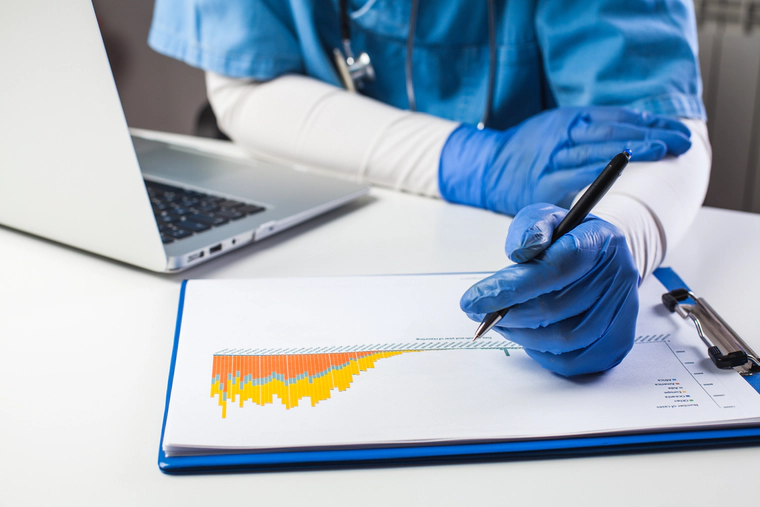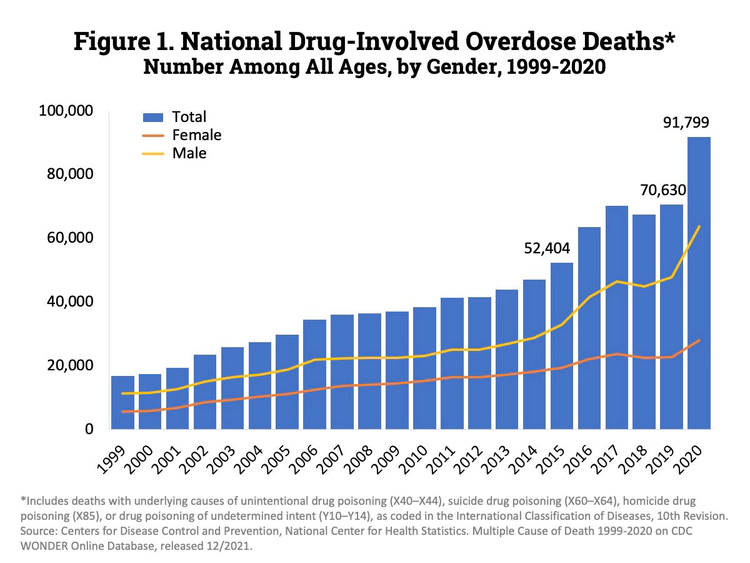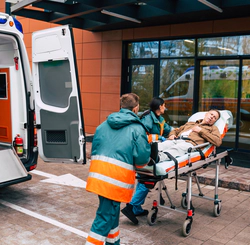Without Sufficient Drug Treatment of Addicts, Current Overdose Plateau Will Not Last
Overdose deaths may be dipping, but this should not be taken as a sign the addiction epidemic is under control. Overdoses dipped in 2018, then skyrocketed in 2019, 2020, and 2021.

Annual overdose rates occasionally dip. When this occurs, some interpret the dip as a sign the addiction and overdose epidemic is receding. Unfortunately, such dips are always temporary, and overdoses rise the next year, almost always far outpacing the dip.
The U.S. will not achieve lasting change in its addiction crisis until treatment is available for all addicts. Americans must understand that when no broader solution is presented to solve the addiction problem, any perceived drop or “leveling-out” in drug overdoses will be fleeting at best.
Year-to-Year Overdoses May Ebb and Flow, but the Broader Trend is Always a Long-Term Increase in Deaths
The Centers for Disease Control and Prevention reported that, between July 2021 and June 2022, 107,600 people died from drug overdoses. This figure is 40 deaths fewer than the 107,640 people who died from drug overdoses between July 2020 and June 2021.1
While any drop in deaths should be recognized as good news, there is no guarantee the drop will stabilize. According to the National Institute on Drug Abuse, overdose deaths have increased by about 400% since 1999. Even when some years show a small dip in fatalities, such as in 2018, the following years always record a significant spike. For example, about 70,000 Americans died from drug overdoses in 2017. That figure fell to 67,000 deaths in 2018. Then 70,630 lost their lives in 2019, 91,799 died in 2020, and over 107,000 died from overdoses in 2021.2

Brief dips in overdoses are not sustainable because the U.S. is not addressing the root cause of overdoses, i.e., addiction.
The Decrease that’s Occurring is Uneven at Best
Examining the decrease that some researchers highlight between 2021 and 2022, only eight states reported a drop in overdose deaths. These were states that had been devastated by addiction crises in previous years. Unfortunately, all other states recorded an increase in overdoses.
For the states that recorded decreases, public health officials cited successful actions like health education campaigns to warn the public about the dangers of drug use, expanded treatment for those struggling with drug abuse, and wider distribution of the overdose-reversing medication naloxone to addicts and their families. These methods are truly beneficial, but they need to be expanded and applied at scale if states are to make real, lasting, and tangible progress in the fight to end addiction in America.
Rather than Celebrating Dips, Push for a Permanent End to the Addiction Epidemic
While some see the 2021-2022 drop in overdoses as a victory, it would be better perceived as a rallying cry to keep applying maximum effort toward treating addicts and protecting people from overdoses. To that point, many public health officials are warning the American people not to rest on their laurels and make the same mistake that many made at the end of 2018 when records indicated overdoses had fallen 4%.
“You can’t celebrate every time you see a slight downturn…”
Dr. Donald Burke, former Dean of Pittsburg School of Public Health, warned Americans not to celebrate the 40-death drop between 2021 and 2022. “You can’t celebrate every time you see a slight downturn,” he said. Dr. Burke went on to draw parallels between the 2018 drop and the 2022 drop, reminding Americans that the overdose drop in 2018 was not permanent. No signs or data suggest the 2022 drop will be permanent either.

Small changes in year-over-year overdose rates are more likely the result of very slight shifts in policy and global shifts in drug production and trafficking. And while we should recognize such shifts for having a net positive effect, they are not enough to produce lasting change. Americans should save their celebrations for when real improvements are made in America’s addiction crisis. The only way to achieve those gains is to ensure those who struggle with addiction receive quality treatment.
The Importance of Treatment
Rather than spending valuable resources examining the minutia of year-to-year overdose rates and celebrating the slightest of downturns in deaths, it would seem wiser to focus on helping Americans addicted to drugs. With this in mind, George F. Koob, Ph.D., and director of the National Institute on Alcohol Abuse and Alcoholism said, “Based on these findings, more than 23 million adults in the United States have struggled with problematic drug use. Given these numbers, and other recent findings about the prevalence and under-treatment of alcohol use disorder in the U.S., it is vitally important that we continue our efforts to understand the underlying causes of drug and alcohol addiction, their relationship to other psychiatric conditions, and the most effective forms of treatment.” Truly, if any real progress is to be made in overcoming America’s fatal addiction epidemic, it must begin with helping addicts get off of drugs for good.3
An addiction to drugs and alcohol is not a fleeting problem that goes away on its own. When people use drugs and alcohol to the point where they cannot stop using them, they are addicted to those substances and must seek professional help. Thankfully, qualified residential treatment centers provide a way out for addicts. Such programs provide recovering addicts with the tools they need to tackle and overcome the underlying issues that caused them to turn to drugs and alcohol in the first place.
Sources Cited:
-
USNews. “U.S. Overdose Deaths May Be Peaking, but Experts Are Wary.” U.S. News, 2022. usnews.com ↩︎
-
NIDA. “Overdose Death Rates.” National Institute of Drug Abuse, 2022. nida.nih.gov ↩︎
-
NIH. “10 percent of U.S. adults have drug use disorder at some point in their lives.” National Institutes of Health, 2015. nih.gov ↩︎





 ®
®